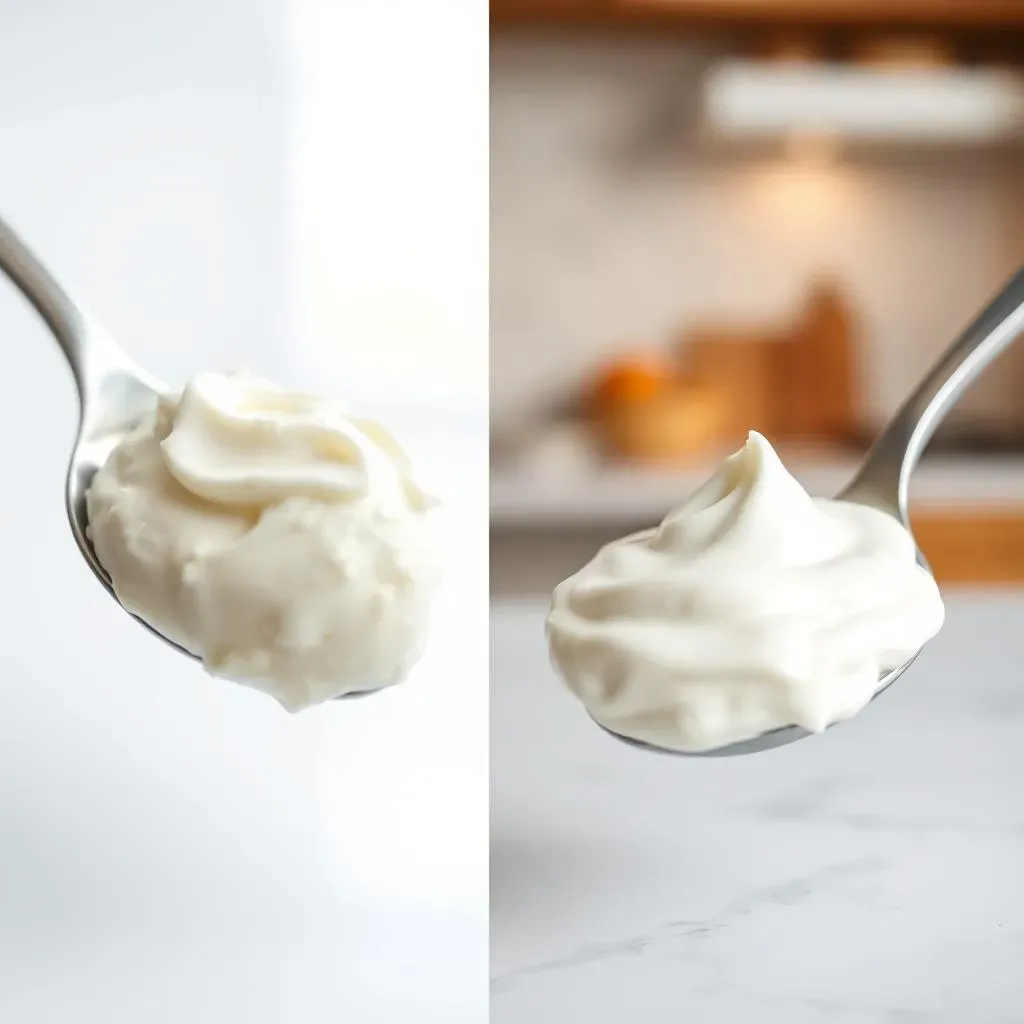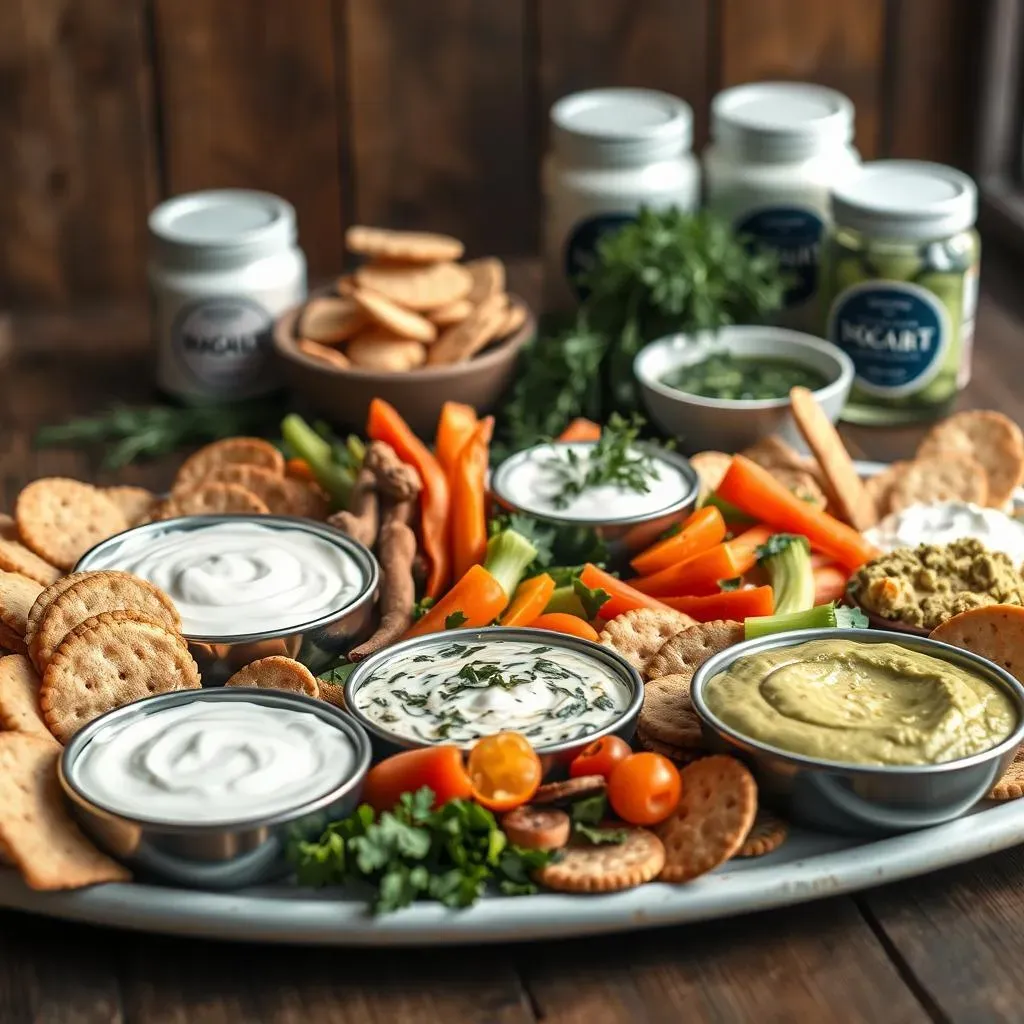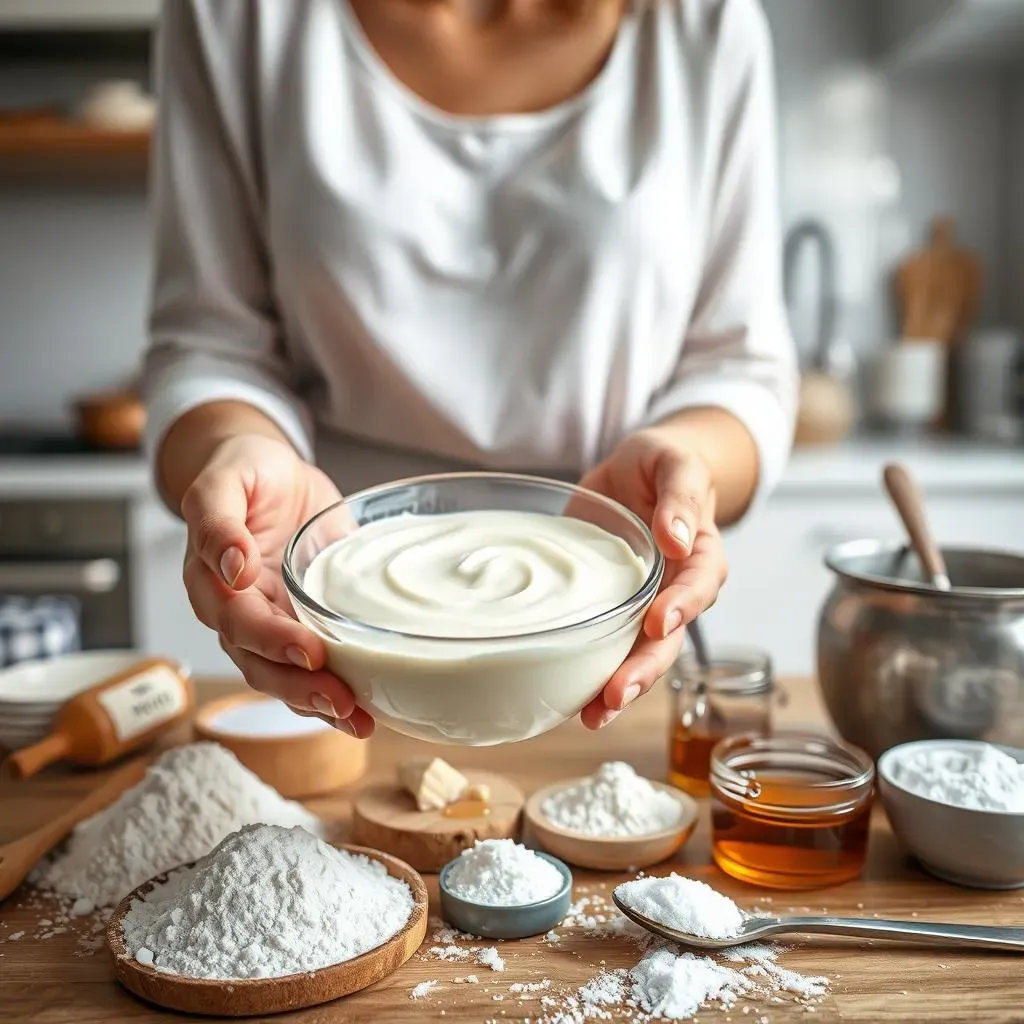Table of Contents
Running low on sour cream? Don't panic! You might already have a fantastic substitute hiding in your fridge: yogurt. This article tackles the burning question: "Can I substitute yogurt for sour cream?" We'll explore the nuances of this swap, going beyond a simple yes or no. First, we'll compare the taste and texture of sour cream and yogurt, helping you understand their similarities and differences. Then, we'll dive into the world of baking, showing you how yogurt can successfully replace sour cream in cakes, cookies, and other treats. Next, we’ll explore savory applications, such as dips, dressings, and sauces. Finally, we'll address common issues and offer troubleshooting tips to ensure your culinary creations are a success. Whether you're a seasoned baker or a kitchen novice, this guide will empower you to confidently use yogurt as a sour cream substitute and unlock a world of delicious possibilities. So, let's get started!
Yogurt vs. Sour Cream: A Taste Test

Yogurt vs. Sour Cream: A Taste Test
Texture Tango: Creamy Comparisons
Let's get down to the nitty-gritty: texture. Sour cream boasts a thick, almost velvety consistency. Think of it as a rich, luxurious cloud. Yogurt, on the other hand, can range from pourable to quite thick, depending on the type. Greek yogurt, for instance, is much thicker than regular yogurt, making it a closer match to sour cream in terms of texture. If you're looking for a direct swap, Greek yogurt is your best bet. Need more sour cream substitute ideas? Check out our guide on sour cream alternatives!
But here's the thing: even the thickest Greek yogurt might not be *exactly* like sour cream. It's a subtle difference, but noticeable to a keen palate. Think of it like this: sour cream is a seasoned pro, while Greek yogurt is a talented up-and-comer. Both are creamy, but have slightly different personalities.
Feature | Sour Cream | Greek Yogurt |
|---|---|---|
Texture | Thick, velvety | Thick (but can vary) |
Acidity | Tangy | Mildly tart (can be adjusted) |
The Tang Factor: Acidity Adventures
Acidity is where things get interesting. Sour cream has a distinctly tangy flavor, a sharp kick that adds zest to many dishes. Yogurt, particularly plain yogurt, has a milder tartness. This tartness can be amplified or toned down depending on the type of yogurt you use. For example, you can add a squeeze of lemon juice to enhance the tang if your recipe calls for a more assertive flavor. Want to explore other dairy options? Learn more about using cottage cheese as a sour cream substitute.
The level of acidity can significantly impact the final taste of your dish. In some recipes, a slightly less tangy yogurt might be perfectly acceptable. In others, the difference could be quite noticeable. Experimentation is key! Remember, you can always adjust the other ingredients to compensate for any differences in taste.
- Consider the recipe's other ingredients.
- Taste as you go, and adjust accordingly.
- Don't be afraid to experiment!
Flavor Finale: A Balancing Act
Beyond texture and tang, the overall flavor profile plays a role. Sour cream has a very specific, almost buttery flavor. Yogurt, especially full-fat varieties, can offer a similar richness, but with a slightly more pronounced lactic tang. In some recipes, this subtle difference might go unnoticed. In others, it could be a game-changer. For example, if you are using sour cream in a dish with a lot of other strong flavors, the difference might be negligible. But if you're using sour cream as a primary flavor component, the substitution might alter the final result. Looking for more substitutions? Check out our post on sour cream vs. creme fraiche!
The best way to determine if a yogurt substitution will work for a particular recipe is to experiment and adjust as needed. Consider the other ingredients in the recipe, and taste as you go. Remember, cooking is all about creativity and adaptation.
Baking with Yogurt Instead of Sour Cream: Cakes, Cookies, and More

Baking with Yogurt Instead of Sour Cream: Cakes, Cookies, and More
Cakes: A Creamy Collaboration
Let's talk cakes! Swapping yogurt for sour cream in cakes is often a surprisingly successful move. The yogurt adds moisture and a subtle tang that can complement many cake flavors. Full-fat Greek yogurt works best, mimicking sour cream's richness. However, remember that yogurt can sometimes be slightly more acidic than sour cream. If your recipe calls for a leavening agent like baking powder, you might need to adjust the amount to compensate for the added acidity. For instance, you might need slightly less baking powder to prevent the cake from rising too much. Need more baking tips? Check out our guide on substituting heavy cream in baking!
Think of it like this: sour cream provides a sturdy base, while yogurt offers a more delicate touch. The results can be delightful! The best way to find out what works for your recipe is to experiment. Start with a small batch, maybe even half the recipe, to see how the yogurt affects the final product. Many recipes will work well with a 1:1 substitution, but some might require a little tweaking.
Cake Type | Yogurt Substitution Notes |
|---|---|
Pound Cake | Works well, adds moisture |
Cheesecake | May require slight reduction in liquid |
Carrot Cake | Enhances the spice notes |
Cookies: A Crumbly Conundrum
Now, let's tackle cookies. This is where things get a bit trickier. Yogurt, with its higher moisture content compared to sour cream, can sometimes make cookies too soft or spread too thin during baking. If you're determined to use yogurt in your cookie recipe, consider reducing the amount of other liquids, such as milk or eggs. This will help balance the moisture content and prevent overly soft cookies. Need help with other baking swaps? Check out this guide on using Greek yogurt in baking!
Again, experimentation is your best friend here. Start with a small batch to see how the yogurt affects the texture and spread of your cookies. You might find that a 1:1 substitution works perfectly, or you might need to adjust the recipe slightly. Remember, even minor adjustments can make a big difference in the final product. Don't be afraid to adjust the baking time as well, since moisture content can affect baking time.
- Reduce other liquids in the recipe.
- Adjust baking time as needed.
- Start with a small test batch.
Savory Substitutions: Dips, Dressings, and Sauces

Savory Substitutions: Dips, Dressings, and Sauces
Dips: A Creamy Delight
Yogurt makes a surprisingly good substitute for sour cream in dips. Think creamy spinach and artichoke dip, or a zesty French onion dip. Full-fat Greek yogurt provides the necessary thickness and richness, while plain yogurt offers a blank canvas for your favorite herbs and spices. The slightly tangier flavor of yogurt can even enhance certain dips, adding a unique twist to classic recipes. Need more dip ideas? Check out our article on sour cream vs. mayo in dips!
However, keep in mind that the tanginess of yogurt might not be suitable for all dips. If you're making a dip that relies heavily on a delicate balance of flavors, you might want to experiment with a small batch first to ensure the yogurt doesn't overpower the other ingredients. You can always adjust the seasoning to compensate for any differences in taste.
Dip Type | Yogurt Substitution Notes |
|---|---|
Spinach Artichoke Dip | Excellent substitute, adds creaminess |
French Onion Dip | Adds a tangy twist |
Guacamole | Use cautiously, may alter the flavor profile |
Dressings and Sauces: A Flavorful Fusion
Yogurt also works well as a sour cream substitute in many dressings and sauces. Think creamy ranch dressing, a zesty cilantro-lime dressing, or a rich and creamy pasta sauce. The creamy texture of Greek yogurt can mimic the richness of sour cream, while its mild tang adds a refreshing touch to these dishes. For example, a creamy dill sauce for fish benefits from the yogurt's subtly tart notes. Want to know more about using yogurt in different recipes? Check out our comprehensive guide on substituting Greek yogurt for sour cream!
However, the thinner consistency of some yogurts might require you to adjust the thickness of your dressing or sauce. You might need to add a thickening agent, such as cornstarch or flour, to achieve the desired consistency. Remember that the flavor profile of yogurt is slightly different than sour cream, so you may want to adjust the seasonings accordingly. A little experimentation will go a long way!
- Adjust thickness with cornstarch or flour.
- Taste and adjust seasonings as needed.
- Experiment with different types of yogurt.
Troubleshooting Common Yogurt Substitutions

Troubleshooting Common Yogurt Substitutions
Too Thin? Too Tangy? Common Problems Solved
So, you've swapped in yogurt for sour cream, and things aren't quite right. Don't worry, it happens! One common issue is a thinner consistency than expected. If your recipe needs a thicker texture, you can easily thicken things up. Simply stir in a tablespoon or two of cornstarch or flour, whisking it in until smooth. Let it sit for a few minutes to allow the thickener to work its magic. Another common problem is excessive tang. If the yogurt's tartness overpowers your dish, try balancing it with a touch of sugar or honey. A pinch of salt can also help to enhance the other flavors and mellow out the acidity. Need more tips on dairy substitutions? See our guide on sour cream vs. sour milk!
Sometimes, the yogurt's texture just doesn't quite cut it. If you're aiming for that signature sour cream creaminess, full-fat Greek yogurt is your best bet. However, even Greek yogurt might not be as rich as sour cream, which can be especially noticeable in recipes that rely heavily on the creaminess of sour cream, such as certain dips or sauces. If that's the case, consider adding a dollop of heavy cream or crème fraîche to boost the richness. Remember, a little experimentation goes a long way!
- Use cornstarch or flour to thicken.
- Add sugar or honey to reduce tanginess.
- Enhance flavors with a pinch of salt.
Adjusting for Acidity and Flavor
Yogurt's acidity can be a double-edged sword. While it adds a nice tang to some dishes, it can overpower others. If you find your dish too tart after adding yogurt, a dash of baking soda can help neutralize the acidity. Baking soda is a base, and it reacts with the acid in the yogurt, creating a more neutral pH. Just be careful not to add too much; a little goes a long way! Another approach is to simply adjust the other seasonings in your recipe. For instance, if you're making a creamy tomato sauce, you might want to add a little more sugar or herbs to balance the tartness of the yogurt. Need help with other sauce recipes? Check out our article on sour cream vs. mayo in sauces!
Remember, taste as you go! This is crucial, especially when making substitutions. Start with a smaller amount of yogurt than the recipe calls for, and add more as needed. This way, you can better control the acidity and flavor of your dish. If you're still unsure, it's always a good idea to test a small batch of your recipe before making a large quantity. This allows you to make adjustments without wasting a lot of ingredients.
Problem | Solution |
|---|---|
Too tangy | Add a pinch of baking soda or sugar |
Too thin | Add cornstarch or flour |
Not creamy enough | Add a dollop of heavy cream |